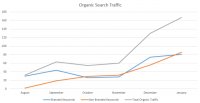 In August 2012, we launched a new website targeting health and fitness clubs on a subdomain. I’d like to share some of the data we've collected over the past six months, so you can see what it’s like to launch a new website on a new domain, where you can expect traffic to come from and how that traffic differs from what you might see on a more established domain.
In August 2012, we launched a new website targeting health and fitness clubs on a subdomain. I’d like to share some of the data we've collected over the past six months, so you can see what it’s like to launch a new website on a new domain, where you can expect traffic to come from and how that traffic differs from what you might see on a more established domain.
Planning
Before the launch, we spent months tinkering with the layout, design concepts and content. But just as importantly, we also spent a good deal of time planning our marketing campaign for this website.
Our plan included SEO and social media, but since we were starting with a new subdomain and were pushing into a vertical where we had no existing presence, we knew that SEO and social media alone wouldn't cut it.
We researched our potential clients and started building an email list. We looked into the tools our potential clients were using, made sure our product integrated with those tools and then reached out to those companies to establish a marketing partnership.
We planned waves of email campaigns, looked into advertising platforms and built a marketing campaign that leveraged multiple sources, all of which funneled traffic to our new website.
So did all this work pay off? I’d say yes, for the most part. We haven’t started dominating the world of health club websites, but we’re off to a solid start.
A look at the data
Let’s jump right into the graph that I think best sums up the point I’ll be trying to make in this article. One glance shows you that the sources driving traffic to our health clubs subdomain are wildly different from our more established primary domain.
Taking a closer look we can see that big bumps in our traffic came from email campaigns. These played an important role in establishing a foothold in a new vertical by bringing our site to a large audience and spreading brand awareness.
The other thing that might come as a surprise to some is the small amount of Search Traffic that we received on our health club site. People sometimes have the misconception that search engines will immediately start sending traffic to their website. This is rarely the case however, especially with new websites.
 Search engines want to provide their users with the quality answers they are looking for. Your new website might be high-quality, but without an established presence online, Google and other search engines have very little reason to see your site as authoritative.
Search engines want to provide their users with the quality answers they are looking for. Your new website might be high-quality, but without an established presence online, Google and other search engines have very little reason to see your site as authoritative.
It takes time to build a strong Internet presence through content marketing, social sharing, building inbound links, etc. And then it takes time for search engines to recognize the strong presence and adjust rankings accordingly.
Let’s take a closer look at the organic search traffic from our health club website to see what I mean.
We didn't start to gain much traction with search traffic until 5 months after launch, and it wasn't until a few weeks ago that we started ranking on the first page for our primary keywords. Even though all the SEO work we did pre-launch and over the first few months didn't show immediate results, in the end, it definitely paid off with big increases in search traffic in December and January.
What does this mean for you?
If you have a brand new domain, it means that you shouldn’t depend on Search Traffic to be your saving grace. Building a successful online presence from scratch requires market research, understanding your audience and discovering new marketing opportunities.
I’m not saying you should ignore SEO - far from it. SEO and social media should still be key aspects of your online marketing strategy. The lesson to learn here is that these traffic sources likely won’t drive huge amounts of traffic to your site right away, so you should be prepared with other tactics to fill the void. You also shouldn't feel disheartened by a lack of search traffic after launching your site. Achieving SERP domination takes time and a lot of work.
I’d also like to make a point here that everything above applies to brand new domains that have just been registered. More established domains (even if you've completely redesigned your website) will behave much differently. Even then, the results we've seen with our health club subdomain may not be indicative of what you’ll see on your new domain.











